Main menu
Common skin conditions

NEWS
Join DermNet PRO
Read more
Quick links
Skin problems in hairdressers and barbers — extra information
Skin problems in hairdressers and barbers
Author: Susan Ford BSc (Hons) Occupational Health, 2012.
Introduction
Occupational rissk
Causes
Skin conditions associated with hairdressing
Workplace risk assessment
Health surveillance
Personal protective equipment
Hand care advice
Treatment
Introduction
Occupational hand dermatitis in hairdressers was first described as early as 1898 and still today up to 70% of hairdressers suffer some form of skin damage during their career. Hand dermatitis in hairdressers is the second most commonly notified occupational skin disease in women.
Hand dermatitis in hairdressers
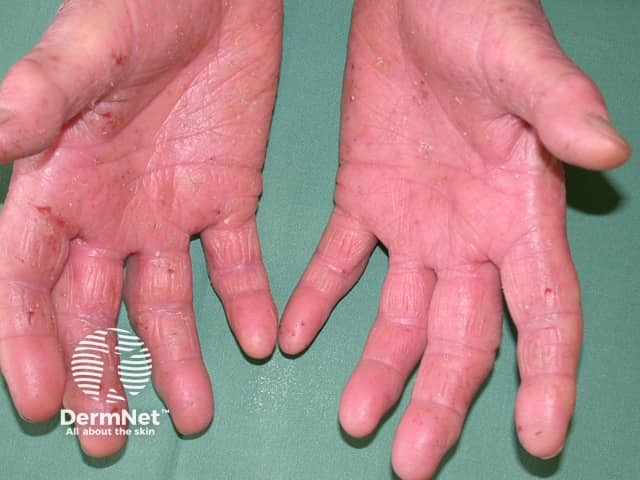
Hand dermatitis in hairdresser
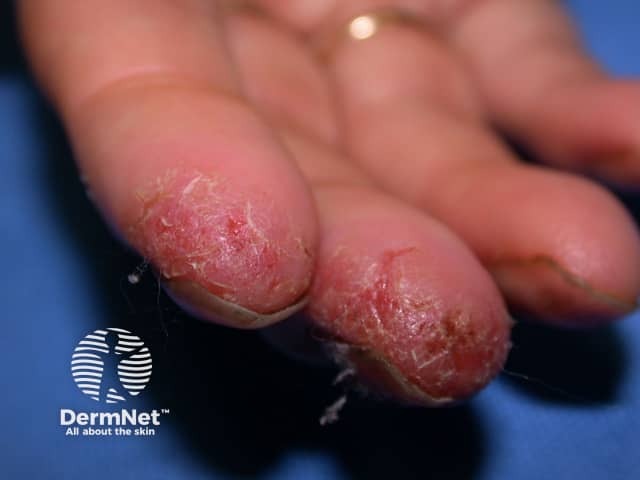
Hand dermatitis in hairdresser
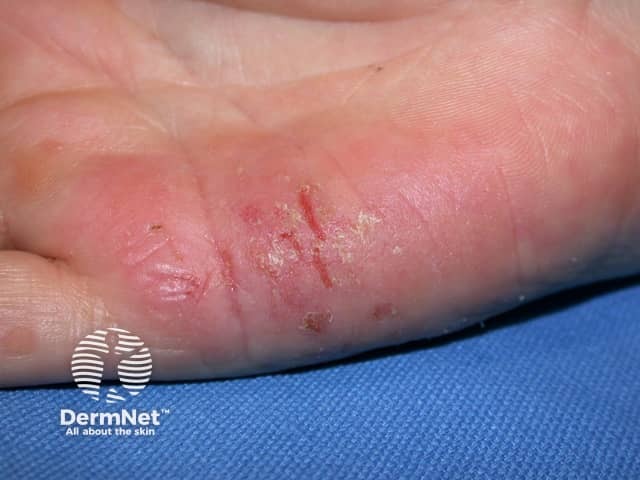
Hand dermatitis in hairdresser
Why do hairdressers have skin problems?
Hand dermatitis in hairdressers and barbers is caused by three main factors.
- Exposure to irritants: repeated contact with water and detergents; prolonged glove-wearing; irritating hairdressing chemicals; physical irritants such as hot air and hair;
- Exposure to potential allergens including hair dyes and bleaches;
- Pre-existing sensitive skin or atopic dermatitis (eczema).
Apprentices and juniors spend a lot of time at the basin, so are susceptible to occupationally related skin disease, especially if there is a history of eczema or asthma. An estimated 14–20% of students in the UK drop out of training in the first two years due to contact dermatitis.
Individuals with skin sensitivity and pre-existing atopic dermatitis at the pre-training/employment stage should consider whether hairdressing is a sensible career option. If they choose to proceed, they should take precautions throughout their career to reduce or avoid skin exposure to contact irritants and allergens.
Skin hazards in a hairdressing salon
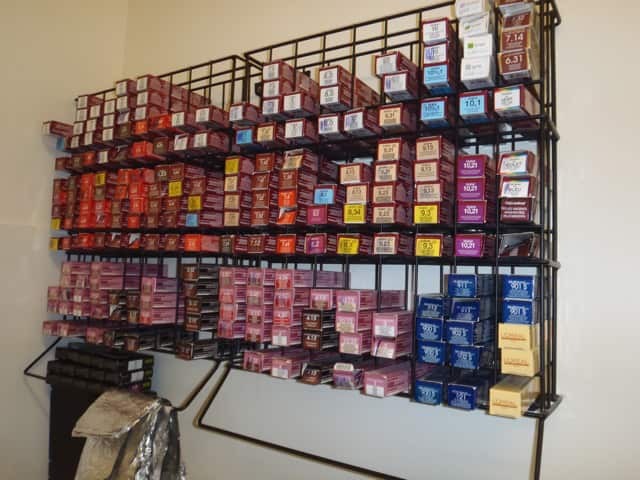
Chemicals in a hairdressing salon
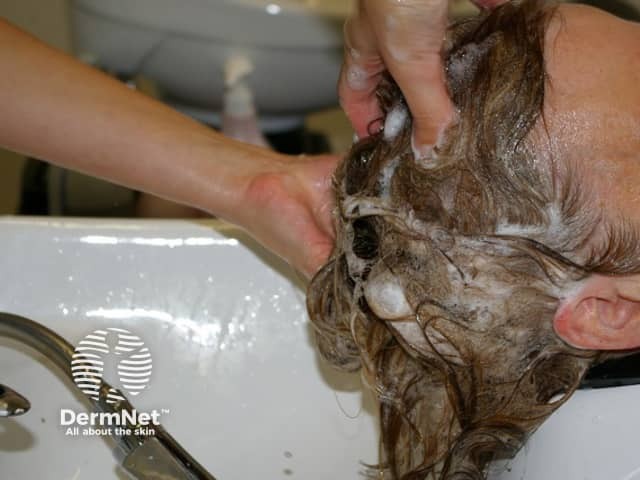
Shampooing in a salon
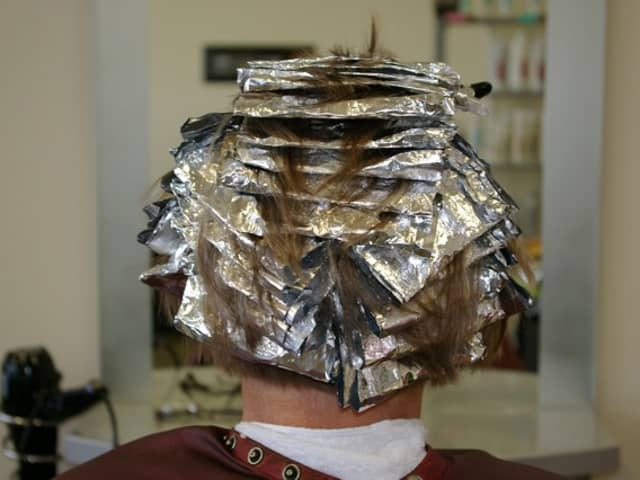
Applying colour in a salon
Understanding the causes of occupational skin disease
The outermost layer of the skin (the horny cell layer of the epidermis) acts as a barrier to prevent infection and to prevent potential allergens from penetrating the skin. Its pH is slightly acidic which can help to neutralise the degreasing agents that are in soaps, which are alkaline. Excessive use of soaps and some detergents can destroy the acidity and de-fat the surface skin and therefore the protection it offers.
If the moisture content is too high (overhydrated skin) or too low (dry skin), the skin barrier may also be less effective. Natural moisturising factors are diluted and may be washed out of the skin.
Skin conditions associated with hairdressing
Irritant contact dermatitis
Irritant contact dermatitis occurs when physical or chemical damage to the barrier layer of the skin exceeds the skin’s ability to repair the damage. Examples include:
- Overhydration due to repeated exposure to water, or sweating inside gloves
- Contact with shampoos and other irritant chemicals
- Friction from hair shafts, scissors, combs and other instruments
- Drying the skin with the use of hairdryers.
The features of irritant contact dermatitis are varied.
- Irritant contact dermatitis may be a single episode that recovers, repeated relapsing episodes, or chronic dermatitis due to repetitive injury.
- In general, the degree of damage following irritant exposure depends on the potency of the irritant, the duration of application, the frequency of exposure, occlusion, temperature, anatomical site, and individual susceptibility.
- Where there is repeated exposure, previous damage may render the skin more susceptible to damage from the next exposure. However, hardening may also occur.
- Because contact irritant dermatitis is dose-dependent, it tends to be restricted to the site of primary contact, which is usually the hands. A reduction in the cumulative exposure to irritants lessens the risk of dermatitis. Conversely, occlusion of the irritating chemical(s) or particulates by gloves, jewellery such as wedding rings or wristwatch can aggravate dermatitis.
- Dermatitis may be dry, flaking, and fissuring; or erythematous, swollen, blistering, weeping, and eroded.
- Broken skin leads to a risk of a skin infection, presenting as red, swollen skin with ulceration, oozing or pustules.
Allergic contact dermatitis
Allergic contact dermatitis is an immunological response to an allergen. Only people who are allergic to a specific agent (the allergen) will show symptoms. The appearance can be exactly the same as irritant contact dermatitis. There are some specific features of allergic contact dermatitis.
- The allergen may have been previously tolerated for years without causing dermatitis.
- Once sensitised, the reaction may occur with minimal exposure to the allergen.
- Dermatitis may occur not only at the site of primary contact but also at secondary sites. For example, a person who is allergic to rubber gloves may not only get dermatitis on their hands but also dermatitis on the face or neck, where they transferred tiny amounts of allergen by accident.
- Dermatitis occurs within hours or days of exposure to the allergen.
- Symptoms settle down when the skin is no longer in contact with the allergen, although this may take weeks and require treatment.
- Allergic contact dermatitis can usually be confirmed by patch tests.
- Dermatitis may spread to involve other sites of minimal or no exposure to the causative agent
- There is no cure so avoiding exposure is the only way to avoid further episodes.
Nickel allergy is the most common form of allergic contact dermatitis in hairdressers and others.
- Approximately 11% of all adult women are nickel sensitive. Nickel allergy is less common in males.
- Dermatitis arises in sites of contact with belt buckles, wristwatches and other jewellery and nickel-releasing metal tools and surfaces at work.
- Dermatitis is more likely in hot humid conditions.
The wearing of jewellery whilst at work should be discouraged, and any tools (eg, scissors) should be nickel-free.
Common examples of allergic contact dermatitis in hairdressers include:
- Contact allergy to preservatives – these are found in shampoos, conditioners, hand creams and indeed any product which contains water.
- Perfume and fragrance contact allergy
- Paraphenylenediamine and hair dye contact allergy and reactions to bleaches such as hydrogen peroxide and ammonium persulfate.
- Glyceryl monothioglycolate allergy (acid perming solution)
- Contact allergy to rubber antioxidants in gloves.
Rubber gloves may also result in contact urticaria, which is due to rubber latex allergy.
Hand infection
Bacterial infection (impetigo, boils and folliculitis) is usually caused by Staphylococcus aureus and or Streptococcus pyogenes.
Hand dermatitis and wet work also predispose to yeast infection, usually presenting as chronic paronychia infected by Candida albicans or as intertrigo between the fingers (also called erosio interdigitalis blastomycetica).
Skin infections in hairdressers
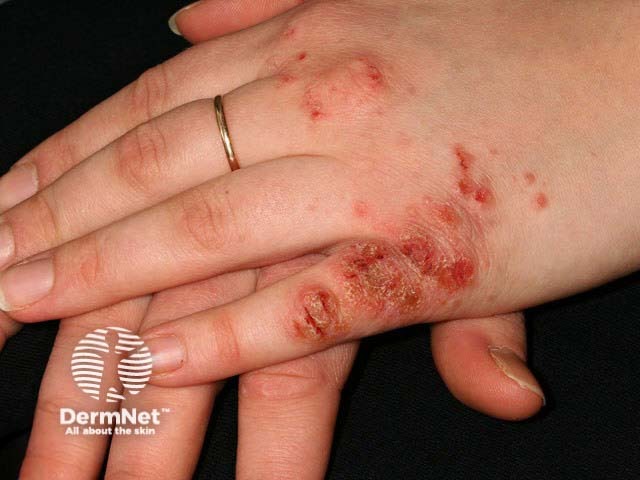
Infected hand dermatitis

Candida intertrigo
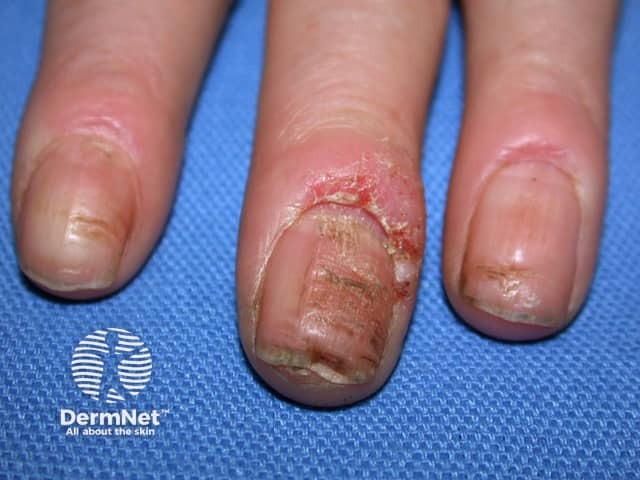
Paronychia
Hair shaft injuries
The shafts of a client’s hair can be as sharp as a needle and may penetrate the skin on the hands or under the fingernails, and occasionally other exposed sites. The foreign-body splinters may result in irritation, pain or infection.
Interdigital pilonidal sinuses ('pilus' meaning hair and 'nidal' meaning nest) are less common. They are typically found in the clefts between the fingers of hairdressers and barbers, where the skin is thin and moist. If the sinuses become infected, a pilonidal abscess may form.
Mechanical injuries in hairdressers
Mechanical injuries may be caused by:
- Scissors
- Razors
- Hot surfaces, such as blow dryers, heated tongs and straightening irons.
Scissor and razor wounds often affect the web between the index and middle fingers of the non-dominant hand (the comb hand). The risk can be reduced by holding the hair with the index and second fingers of the hand pressed together, one on top of the other. This closes the gap between the fingers.
Straightening irons and hair dryers cause thermal burns to the fingers and wrist of the non-dominant hand and repeated burn trauma over time can lead to scarring.
Workplace risk assessment
Workplace risk assessments identify ‘hazards’ (anything that has the potential to cause harm) and ‘risk’ (the likelihood of an event occurring). The aim should be to reduce these, as ill-health can adversely affect the quality of life, the ability to work in a chosen industry, insurance costs and litigation claims. A generic risk assessment in any hairdressing salon should include a specific section on skin exposure and should cover:
- Hazardous properties and adverse health effects of wet work
- Hazardous properties and adverse health effects from the exposure to chemicals
- Frequency and duration of exposure
- Controls and their effectiveness
- Personal protective equipment
- Staff education and training including familiarity with the Material Safety Data Sheets for chemicals and products used in the workplace.
Results of the risk assessment must be recorded and kept.
Health surveillance
Health surveillance should be carried out when a workplace hazard is minimised rather than eliminated Staff should be encouraged to report any signs of skin problems and all reasonable steps should be taken to resolve the problem and prevent recurrences. This may involve a referral for medical advice.
Personal protective equipment — gloves for hairdressers and barbers
Follow the manufacturer’s recommendations for the personal protective equipment (PPE) needed for hands and eyes during mixing, application and washing out of hairdressing chemicals. Large manufacturers of hairdressing chemicals often provide technical advisors who attend salons on a regular basis to offer training and advice about their products, as well as telephone helplines.
Disadvantages of gloves
Gloves can be inconvenient to use due to the lack of sensation/dexterity required to cut hair, apply foils and so forth. They are not popular with clients as they snag and pull on the hair. Prolonged glove wearing can result in irritant dermatitis, or contact allergy to glove constituents may develop.
Advantages of gloves
Gloves protect the individual from contact with irritants and allergens.
How to wear gloves
To maximise the benefits and minimise the disadvantages of gloves they should be:
- Worn only on dry skin
- Fit for purpose, well-fitting and offered in different sizes
- Gauntlet-type when washing and rinsing hair and when mixing and applying chemicals to cover the wrist and prevent splashes down inside the glove
- Disposable and single-use
- Made from nitrile, vinyl, or polyethylene materials, which are less likely to cause allergy compared to rubber
- Rinsed before removal
- Removed safely to avoid contamination.
Good hand care advice for hairdressers and barbers
Do Not
- Allow repeated or prolonged contact with water; wear gloves when carrying out wet work;
- Allow repeated or prolonged contact with chemicals on the skin;
- Allow skin to come into contact with contaminated work surfaces, gloves, towels etc.
Do
- Avoid hand and wrist jewellery whilst at work to prevent nickel allergy, and also to prevent chemical solutions from becoming trapped between the surface of the jewellery and the skin;
- Dry hands thoroughly with a soft cotton or paper towel — pay particular attention to fingertips, webs and wrists;
- Moisturise hands often with non-perfumed barrier creams, paying particular attention to the fingertips, interdigital space and wrists, especially at the beginning and end of each working day;
- Check skin regularly for early signs of dermatitis;
- Report symptoms to your employer who may need to refer you to an occupational doctor or nurse.
Hairdressing client skincare
It is inevitable that hairdressing clients will be directly exposed to the same irritants and allergens as the hairdresser or barber. Prior to any exposure of a chemical product, a discussion should take place between the hairdresser and client covering the following.
- History of skin disease
- History of sensitivity
- History of past problems with hair products
If the client has had skin problems or has reacted to hair products in the past, it is advisable to patch test the chemical prior to use. Most Material Safety Data Sheets for products used on the hair or skin recommend that a patch test be performed 48 hours in advance of application. Repeated contact allergic reactions, especially to paraphenylenediamine in hair dye, can be very serious and prolonged.
In-salon patch tests involve mixing a small amount of the chemical and applying it to a small area of cleaned skin, typically the inner aspect of the forearm or behind the ear, and covering it with an adhesive dressing.
If any sign of inflammation is present after 24 to 48 hours, the treatment should not proceed. The client should be advised to seek the advice of their medical practitioner. They may be referred to a dermatologist for formal patch tests.
Always ensure advice on the MSDS is followed and only ever use recommended concentrations.
What is the treatment of occupational skin disease?
If a hairdresser or barber has developed hand dermatitis, management may include:
- Minimise contact with irritants (water, detergents, friction, acids, alkalis, strong chemicals)
- Avoid known allergens
- Optimise skin barrier function with suitable emollients, barrier and moisturising creams applied frequently during work and at home
- Potent topical corticosteroids applied to active dermatitis for flare-ups
- Antibiotics for secondary infection.
References
- Afthimiadas C, Kosmidis C, Anthimidis, Grigoriou M, Levva S, Panagiotis F, Psihidis G 2008 Barber’s hair sinus in a female hairdresser: uncommon manifestation of an occupational disease: a case report.
- Health and Safety in Hairdressing – An Evaluation of Health and Safety Management Practices in the Hair Dressing Industry. Department of Labour August 2007 ISBN 978-0-478-28123-1 Pages 39-42, 44-45
- Hogan DJ Subungual trichogranuloma in a hair dresser. Department of Medicine, University of Saskatchewen
- Howard M (2006) Occupational Contact Dermatitis in Hairdressing Workers: A Review of the epidemiological evidence and literature. Journal of Environmental Health research Volume 5 Issue 1
- The Cosmetic, Toiletry and Fragrance Association of New Zealand (CTFA), which provides a list of chemicals that can cause skin disease on exposure
- The New Zealand Hairdressing Industry Training Organization Inc (HITO)
- New Zealand Association of Registered Hair Dressers (NZARH)
- Skin at Work – Hairdressing Health and Safety Executive (HSE) (Accessed April 2012)
- Health and Safety in Hairdressing - An Evaluation – Department of Labour (2007)
- Hair and beauty careers advice – Skin@Work, Occupational Dermatology Research and Education Centre, Victoria, Australia
On DermNet
- Hand dermatitis
- Dermatitis
- Contact dermatitis
- Skin conditions in beauticians
- Occupational skin disorders
- Personal protective equipment
- Fingertip dermatitis
Other websites
- SafeHair Skin and Beauty Toolbox
- Contact Dermatitis in Hairdressers, 10 Years Later: Patch-Test Results in 300 Hairdressers (1994 to 2003) and Comparison with Previous Study – Medscape Dermatology News
